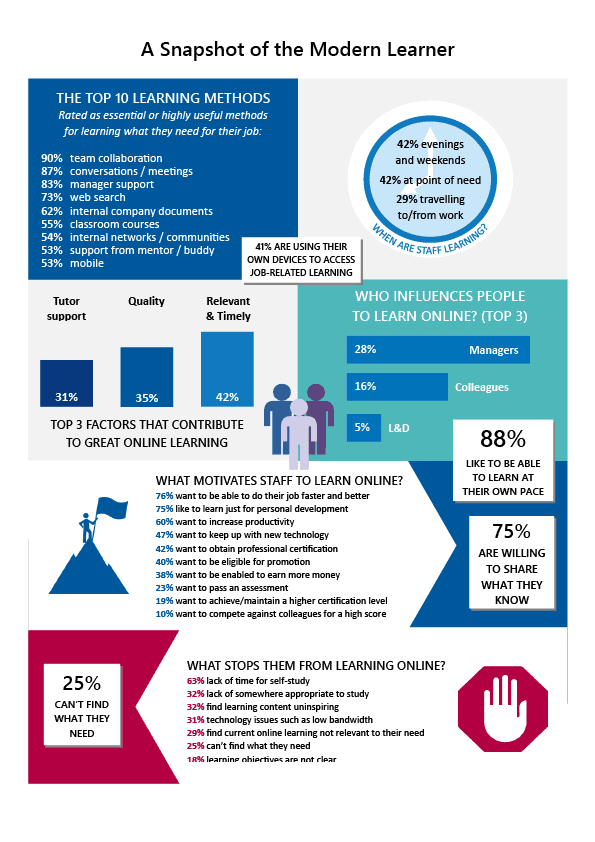
The modern learner. Regardless of educational background, these individuals have experienced all sorts of different learning methods to learn new skills for their career.
These are people who are busy, easily distracted, and who want to learn on their terms. They are hungry for information, using multiple devices to communicate, they have priorities, deadlines, and commitments. And most likely, if you are reading this now, the modern learner is you.
And as a modern learner, you know that the professional learning environment is no longer what it used to be.
Any kind of face-to-face (F2F) work or learning opportunities are now at a standstill due to the global pandemic. The move to digital learning is no longer a “nice to have”, but rather an organizational need. However, the traditional approach to pursuing online education has left many organizations and their employees at a loss, with many training teams seeing little to no engagement in their online courses.
Professionals are more and more often left overwhelmed not understanding why the recently modernized strategy, supported by the newest technology, is not returning the expected results.
How can we provide the right learning materials to enable the modern learner to gain the skill set they need to thrive in the new normal?
The Modern Learner Profile: What we know
Emerald Works created a Snapshot of the Modern Learner – Embracing Change (see infographic above) which shows us an overview the modern learner.
Top learning methods
The top 3 learning methods:
- Team collaboration
- Conversations/meetings
- Manager support
This highlights the need for social interaction when learning. This is an important factor when developing digital learning programs for your teams. Since most classroom settings are no longer an option for most, L&D teams have been struggling to supplement the social factor of professional learning. What they often fail to recognize is that moving from face-to-face training to digital is much more than moving from a classroom setting to putting an instructor behind a camera. The modern learner requires a digital community where they can share their learning experiences with others. According to Harvard Business Publishing, implementing the right tools to facilitate an online community “helps create communities that strengthen the group’s shared purpose, vision, and goals.”
When and how to learn
Our modern learners are learning at times of their convenience. It is a great sign that modern learners are interested in pursuing learning outside of their normal working hours. This proves the demand for providing access to the right kind of digital learning programs.
Learning used to be seen as a long-term process which required consistency, repetition and time to settle. While all that is still true, the reality is that the digital learners are more impatient and expect shorter learning cycles.
Organizations need to reach learners wherever they are. They have to provide solutions (such as mobile learning) for all possible scenarios: working in between flights, or to someone working in a remote location without an internet connection.
Today’s modern learner wants relevant information that is directly related to their field of work and that is available on the go. Learning online is streamlined though the use of smartphones, providing access to content at the time of need for the user. For most modern learners, acquiring critical knowledge for their professions is usually demanded at a moment’s notice, leaving smartphones as the obvious method for obtaining information at moment it is needed.
What motivates learners to learn online?
Learning online comes with many advantages, but the motivation behind it comes from:
- Wanting to be able to do their job better and faster
- Wanting to learn for personal development
- Wanting to increase productivity
We know the modern learner is motivated to develop and implement their professional skillset. In fact, 60% of IT professionals have paid for their training themselves. L&D managers and organizations need to meet them halfway by building and securing the proper context for effective learning to take place. This includes the technology, the necessary time as well as a tailor-made learning path for each employee.
As you may know, the response to supplementing F2F with digital has been remarkable. However, just like all industries, HR and L&D were expected to respond to the immediate demands of digital transformation to make processes more efficient and accessible.
It’s important to take this into consideration, because learning online does not always appeal to the modern learner, because of:
- Lack of time for self study
- Lack of somewhere appropriate to study
- Finding learning content uninspiring
Taking the time to identify where you can implement digital learning will motivate your modern learners and appeal to them even in times when they are lacking motivation.
Learn more about the latest in learning technologies in this Top 10 Learning Technologies Infographic.
Prepare your modern learners for the new normal
In addition to the snapshot from Emerald Works, research conducted by Deloitte portraits “The Modern Learner”, as an individual characterized as “impatient, easily distracted, with a thirst for learning, but at the same time overwhelmed and often overworked.”
The following steps will help you prepare your modern learners for developing their professional skills in the most effective way possible, and at their convenience.
Redesign the Learning Cycle
Learning used to be seen as a long-term process with a one-size-fits-all approach- requiring consistency, repetition and time to settle. While most of this still rings true, the reality shows us that digital learners are more impatient than ever and expect shorter learning cycles and faster turnaround.
Empathize with the Learner
Not too long ago, the biggest question regarding L&D content was how to provide better content for learners in order to persuade employees to learn. This is no longer the case. The new generation wants to learn, but they are often overwhelmed with information. Also, their attention span is considerably smaller, with data showing that a user only spends 5 to 10 seconds on a webpage.
Deloitte’s study shows that most learners will not watch videos longer than 4 minutes. This is why trends such as micro-learning are more relevant than ever. The modern learner is no longer willing to commit to a learning process which requires his attention for several hours, especially if the benefit for them is not obvious.
This means that learning content must be created with learning design principles that begin with the learner in order to win and keep the attention and interest of learners. We need to design learning blends that are not only efficient but also attractive to learners. This change is already taking place through the gamification of L&D. By appealing to the needs of learner, you can interact with the emotional aspects of learners, which keeps them actively engaged and interested in learning for a longer amount of time.
Be Flexible
According to a Zapier report, “over 50% of employee Americans have transitioned to working from home.” Flexibility in learning is therefore, the key.
Organizations need to reach learners wherever they are. They must provide solutions (such as mobile learning) for all possible scenarios: working in between flights, or to someone working in a remote location without an internet connection. This means anytime, anywhere, and on any device.
As Deloitte’s study also shows, the “Modern Learner” is motivated to develop and implement their skills, so much so, it’s been reported that many have even paid for their training themselves. L&D managers and organizations need to meet them halfway. They need to build and secure the proper context for successful learning to take place. This includes the technology, the necessary time as well as a tailor-made learning path for each employee.
What matters most to modern learners
As the global pandemic continues to transform our daily lives, it is also transforming the way we deliver learning material in a professional setting. L&D professionals need to explore the complex ways in which the new normal is changing the industry and the patterns of learning.
While the implementation of new tools and technologies has allowed for learning to be re-designed, L&D professionals still face a challenge when it comes to engaging and retaining the modern learner. It seems that the more accessible learning becomes, the harder it is to keep learners happy.
The key is to understand your learners by researching how they think and what their needs are while understanding the significance and complexity of the disruptions taking place in the learning process. Don’t be afraid to step into the shoes of the modern learner and design your L&D strategy accordingly. Now is the time to empower communication for your global workforce by providing the relevant learning materials to support your modern learners to thrive during these unprecedented times.
If you are interested in learning more about supporting your modern learners by moving from face-to-face learning to digital, check out our recent masterclass webinar F2F to Digital Learning – How to successfully adapt

